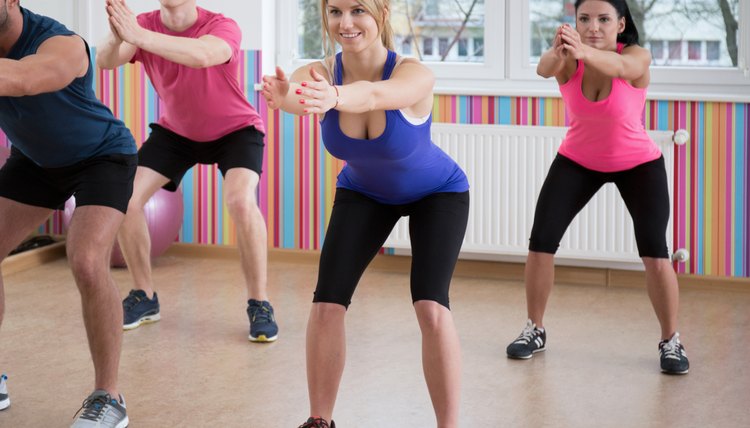Exercises for Hip Hypermobility

Excessive motion around a joint, known as hypermobility, occurs when an individual can move his joint through a greater range of motion than is typical. Sometimes this excessive range of motion can cause stability issues, and when it occurs at the hip, it can also cause complications with mobility. One management technique for hip hypermobility is performing resistance exercise.
Adductor Exercises
The hip adductors are the muscles on the inside of your leg; keeping these muscles strong can reduce excessive lateral motion of the leg. Position yourself on your side, with the top leg situated behind your body. Lift your lower leg 5 to 6 inches off the floor, holding for a slow three count, then return to the beginning position. Perform two to three sets of 20 to 25 repetitions.
Another exercise is the sumo squat. Position your feet wider than shoulder-width apart and your legs externally rotated so that your feet point out at about a 45-degree angle. Reach back with your hips and squat until your legs are parallel to the ground. Hold for a slow three count, then stand back up. Perform two to three sets of eight to 12 repetitions. This also works the hip flexors.
Extension Exercise
Performing a hip bridge works your hip extensor muscles, which can reduce excessive flexion, or forward motion of the leg. This is also a core strengthening exercise, which can help stabilize the muscles of the hip joint.
Lie flat on the floor with your knees bent so that your feet are flat. Tighten your abdominal muscles and push your hips up until they form a straight line with your knees and spine. Hold this position for three deep breaths, squeezing your buttocks muscles. Return to the resting position and repeat. Perform two to three sets of eight to 12 repetitions.
Flexion Exercise
Strengthening the muscles that flex your hip can help reduce excessive extension, or a reverse motion of the leg. Performing a body weight squat allows the muscles of the hip to work much like they would when you move and use them on a daily basis.
Position yourself with your feet slightly wider than shoulder-width apart and toes pointed forward. Reach back with your hips, maintaining a neutral alignment of your spine, and slowly descend toward the ground, all the while still reaching with your hips, until your knees are bent at a 90-degree angle or as far as is comfortable. Stand back up and repeat. Perform two to three sets of eight to 12 repetitions.
References
- Arthritis Research UK: Joint Hypermobility
- "National Strength and Conditioning Association Performance Training Journal"; Exercise to Reduce the Risk of a Groin Strain Injury; Jason Brumitt; October 2009
- Mayo Clinic: Core Exercises
- Mayo Clinic: Weight Training Exercises for Major Muscle Groups
Writer Bio
Tina Hunt works in the health and fitness field and has been writing articles for her fitness center's newsletter, as well as teaching strength training classes, designing training programs, and coaching athletes in all realms of sports. She also has experience presenting seminars on several health- and fitness-related topics.
